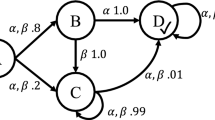Abstract
Using abstract operators for least commitment in planning has been shown to potentially reduce the search space by an exponential factor. However a naive application of these operators can result in an unbounded growth in search space for the worst case. In this paper we investigate another important aspect of abstract operators – that of their construction. Similar to their application, naive construction of an abstract operator may leave you with little search space reduction even in the best case, and significant penalties in the worst. We explain what it means to be a good abstract operator and describe a method of creating good abstract operators.
Access this chapter
Tax calculation will be finalised at checkout
Purchases are for personal use only
Preview
Unable to display preview. Download preview PDF.
Similar content being viewed by others
References
Friedman, M., Weld, D.: Least-commitment action selection. In: AIPS Proc. (1996)
Teutenberg, J., Barley, M.: Abstract operators: A rather technical report (2005)
Joslin, D.: Passive and Active Decision Postponement in Plan Generation. PhD thesis, University of Pittsburgh (1996)
Knoblock, C.: Automatically generating abstractions for problem solving. PhD thesis, Carnegie Mellon University (1991)
Fink, E.: Automatic representation changes in problem solving. PhD thesis, Carnegie Mellon University (1999)
Sacerdoti, E.: Planning in a hierarchy of abstraction spaces. Artificial Intelligence 5, 115–135 (1974)
Tate, A.: Generating project networks. In: IJCAI Proc., pp. 888–893 (1977)
Nau, D., Au, T., Ilghami, O., Kuter, U., Murdock, W., Wu, D., Yaman, F.: Shop2: An htn planning system. Journal of Artifical Intelligence Research 20, 379–404 (2003)
Weld, D.: An introduction to least commitment planning. AI Magazine 15, 27–61 (1994)
Winograd, T.: Understanding Natural Language. Academic Press, London (1972)
Robinson, J.A.: A machine-oriented logic based on the resolution principle. Journal of the Association for Computing Machinery 12, 23–41 (1965)
Author information
Authors and Affiliations
Editor information
Editors and Affiliations
Rights and permissions
Copyright information
© 2005 Springer-Verlag Berlin Heidelberg
About this paper
Cite this paper
Teutenberg, J., Barley, M. (2005). Creating Better Abstract Operators. In: Zucker, JD., Saitta, L. (eds) Abstraction, Reformulation and Approximation. SARA 2005. Lecture Notes in Computer Science(), vol 3607. Springer, Berlin, Heidelberg. https://doi.org/10.1007/11527862_15
Download citation
DOI: https://doi.org/10.1007/11527862_15
Publisher Name: Springer, Berlin, Heidelberg
Print ISBN: 978-3-540-27872-6
Online ISBN: 978-3-540-31882-8
eBook Packages: Computer ScienceComputer Science (R0)




